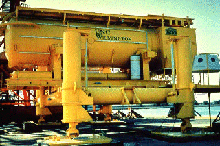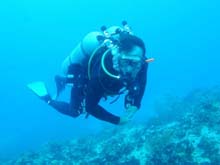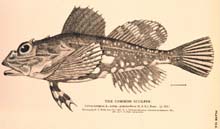|
Ocean Explorers in the Classroom: Aquarius Mission NOAA Voyages of Discovery are designed to convey both the excitement and benefits of ocean exploration into new frontiers with advanced technologies that enable the discovery of ocean secrets previously unknown to humankind. Learn more about the National Marine Sanctuary Aquarius Mission and post questions to the Aquarius aquanauts in the Web Forum.
Background
Project One: Evaluation and Comparison of How Dive Technologies Impact Fish Counts This project will compare fish census data collected using bubble-producing and non-bubble-producing dive equipment. It will also look at the use of night vision equipment to conduct fish counts. Counts of fish will be conducted using stationary diver techniques and/or roving diver techniques (developed by REEF). Divers will record species composition and relative or absolute abundance. Project Two: Technology This project will focus on assessing and evaluating new and emerging technologies that may enhance the ability of National Marine Sanctuary staff to conduct necessary fieldwork and research across the Sanctuary System. The proposed technologies may include underwater data recording devices (e.g., wet PC), geographic positioning systems (GPS) for surface and subsurface data collection, various light sources, low light cameras and film, and underwater digital photographic equipment. The application of some of these technologies will be incorporated into other projects, while some will be evaluated strictly as a component of this project. For each of these technologies, training and hands-on use in the field will be provided. Project Three: Ecological Integrity The proposed investigation seeks to understand the underlying mechanisms that affect rates of social foraging (mixed- and single-species foraging groups) in fish populations and determine if such rates are indicative of the state of ecological integrity in particular habitats. The question is, does social foraging allow greater diversity of fishes per unit of habitat, or, are rates of social foraging simply related to patterns of diversity? In the first case, the behavior serves as one of many possible mechanistic explanations of local patterns in diversity, while in the latter case, the behavior is the result of other processes that explain patterns of diversity. This project is designed to test the effects of landscape variation on rates of social foraging at Conch Reef in the Florida Keys; however, the design and basic principles under examination would be applicable to other types of ecosystems. Social foraging data (counts and species composition of foraging groups) will be collected during censuses on discrete landscape units (i.e., continuous coral reef, patch reef edge with sand, coral rubble, and inter-reefal sand). Project Four: Fish Tagging Researchers will perform fish tagging near the Aquarius underwater habitat. Goals include testing hypotheses to determine if the Conch Reef Research Only Area -- a Marine Protected Area (MPA) -- enhances fish populations by emigration of adults and juveniles to fished areas.
Project Five: Benthic (Sea-floor Bottom) Surveys This project will focus on conducting benthic (sea-floor bottom) surveys to evaluate the percentage of cover of benthic organisms, and the size and condition of coral species in deep reef habitats adjacent to the underwater laboratory. This work will expand and enhance studies started in 1994 that represent the most extensive deep coral-reef monitoring program in the Florida Keys. Several diving technologies (Nitrox, rebreather, and saturation) will be used during this project to compare data quality and collection efficiency associated with each diving system. Project Six: Sponge Surveys Sponges are an important component of Caribbean coral reef communities, yet they are often overlooked in ecological studies. One species, the giant barrel sponge (Xestospongia muta), is particularly prominent on deep-water reefs. Interestingly, like reef-building corals, Xestospongia muta contain photosynthetic symbionts in their tissues. Also, sponges have recently been observed to "bleach" like corals during summer months, which results in death. Two previous Aquarius missions addressed the following questions: (1) How old are these sponges? (2) How often do new sponges appear in the population? (3) How fast do they grow? (4) How common is bleaching? (5) Is bleaching always fatal, or do some sponges recover? (6) How does bleaching affect chemical defenses that the sponge uses against predatory fishes and microbial pathogens? (7) Is bleaching a response to summer temperature extremes, or is it a result of postreproductive trauma? The data collected for this project will resample permanent transects at depths of 18 and 34 m (59 to 112 ft) to provide additional growth and population data. On-line Classroom Activities Courtesy of the Bridge Web site Submersed in Underwater Technology April 2000 Data Tip Technology -- from basic scuba-diving equipment to underwater habitats with satellite links -- has changed our view and knowledge of the oceans. Scientists can now study organisms and environments that were only recently beyond our reach. With this month's data tip, find out more about these amazing new technologies, and use data from an underwater habitat mission to compare the health of corals. Web Forum: September 11-14, 2001 Classrooms can post questions to the aquanauts participating in the National Marine Sanctuary Aquarius Mission. Please enter your name, your school, and your state when you post a question. To ask your questions in the chat room all you need is a connection to the Internet. This text-based interface is easy to use. The moderation feature will ensure that all comments and questions made public are appropriate for students of all ages. Once your questions are posted in the Web forum, they will be answered by the participating aquanauts; their answers will be posted the following day. Webcast: September 17, 2001 Dear Sanctuary Friends, Thank you for your interest in the National Marine Sanctuaries Aquarius Mission 2001! Unfortunately, we have experienced some technical difficulties that cannot be solved before the webcast. That's one of the hazards when you mix the latest technology with saltwater! The Aquanauts and OTHER EXPERTS WILL STILL BE AVAILABLE TO ANSWER YOUR QUESTIONS IN THE CHAT ROOM from 1 to 2 pm Eastern Time and 3 to 4 pm Eastern Time. Join the chat room. When the screen comes up, you will see some messages already posted on the page. If you wish to ask a question, type your name in the appropriate box, type your message in the Message Box, then click on the "Refresh Screen or Submit a Message Button" Messages are screened by a moderator, who will then post them in the chat "room" so it will take a few minutes for your question to appear. Questions with inappropriate content or language will NOT be posted. We look forward to talking to you on-line! NOTE: We will be filming what would have been the broadcast to create a video with the same content. Single copies will be available, free of charge, to the public. If you would like to receive a copy, please email your physical address to Shelley Dupuy. Feel free to ask questions that will be answered by the Aquarius Aquanauts live from 1:00-2:00 PM ET and 3:00-4:00 PM ET. (top) |


